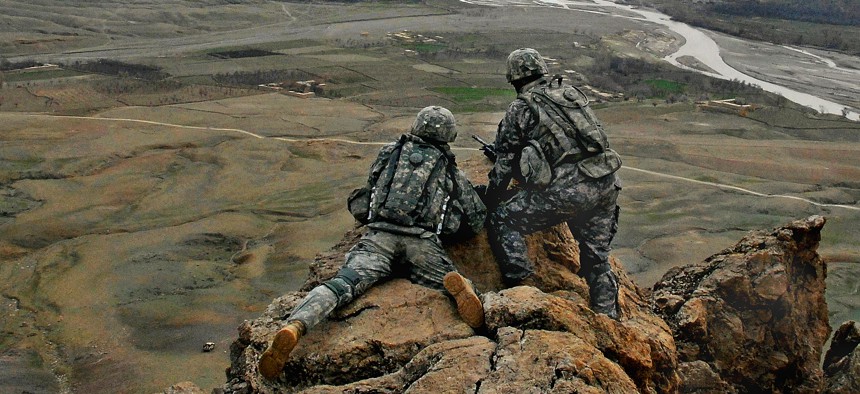
1st Lt. Jared Tomberlin (left) from the 4th Infantry Regiment, gets a first hand view of his new area of responsibility from his predecessor on top of a ridge near Forward Operation Base Lane in the Zabul Province of Afghanistan. U.S. Army / Staff Sergeant Adam Mancini
Pentagon Seeks Sensors That Last for Years
Reducing battery drain by a factor of 1,000 will enable true “persistent surveillance.”
For decades, the military has been looking for ways to collect data and information in places that it can’t put people. One method for doing that is cheap sensors that can be left on the battlefield for extended periods of time, long after soldiers have returned home. Case in point: the 1,500 unattended ground sensors that the Pentagon has requested for the hills and battlefields of Afghanistan.
Getting the most out of a network of sensors means extending battery life as long as possible. That, in turn, means redesigning the way sensors use power and also the way that they do the work that they do. Smarter sensors, ones that actually know what to pay attention to, as opposed to just sit and collect info, could allow for what the military calls “persistent surveillance” on an order of years.
The Defense Advanced Research Projects Agency, or DARPA, today announced a program called Near Zero Power RF and Sensor Operations, or N-ZERO, which will build a network of sensors that can determine what to pay attention to and when. They will have an innate ability to detect specific frequency signatures “such as the presence of a particular vehicle type or radio communications protocol,” according to DARPA.
“Our goal is to use the right signal itself to wake up the sensor, which would improve sensors’ effectiveness and warfighters’ situational awareness by drastically reducing false alarms,” program manager Troy Olsson said in a press release. N-ZERO will build sensors that draw just 10 nanowatts of power during the device’s “asleep yet aware” phase, as much power as a typical watch battery in storage and about 1,000 times less power than is consumed by typical sensors.
It’s a technology that will play a role in some current and future DARPA programs, such as the Upward Falling Payload program, which seeks to put a network of pods on the ocean floor, sleeping quietly, until they sense a particular threat and release their pods.
Undersea pods that lie in wait and spring into action only when they detect, say, a submarine, would cut down on the need for other submarines to collect data on undersea threats. Land-based sensors that can detect military vehicles moving across a border in places like Iraq (or elsewhere) could be connected to armed drones that could also be stationed to lie-in-wait until they are needed, potentially cutting down on the need for drone orbits (patrols) or satellite surveillance.
Persistent ground sensing could radically reduce the costs of gathering intelligence. Sensors that last for years on end would enable far greater capability for the Internet of Things. It could also turn the entire world into a vast, surveillable frontier.
